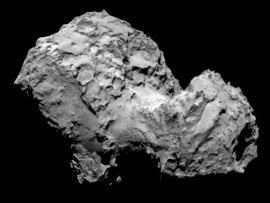Exploring the comets with Rosetta Jérémy Lasue
le 09 oct 2015 de10h00à 12h002015/10/09 2015/10/09

Since the beginning of the space age, our knowledge of the solar system icy bodies has greatly improved. New ice physics processes have been unveiled on the surface of comets and icy satellites. Primordial reservoirs (like the Kuiper belt) have been discovered and are getting further analyzed, by either ground or space-based observations. Numerous space missions are revealing the nature and properties of comets, small bodies enriched in water and complex organic molecules that could have favored the apparition of life on Earth. This talk will describe our current knowledge of the solar system icy bodies and more particularly the comets, in the wake of the Rosetta space mission. The current discoveries of Rosetta at 67P/Churyumov-Gerasimenko will be detailed together with their implications on the formation of planetary systems.




